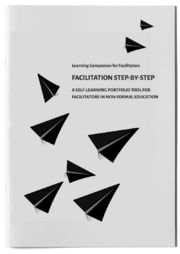Goal
Participants reflect on what they have learned about the topic and on a personal level. They document their thoughts, ideas, and feelings.
Steps
1. Before the meeting starts, prepare a booklet for every participant (bound papers with a nice cover) with different questions and tasks for reflection.
2. You might start with a brief explanation mentioning the goals of the portfolio. The portfolio is an individual instrument for reflection, ideas, and feelings (like a structured diary), thus the participants are free to use it however they wish: they can write, draw, etc. Of course, they can also add more to it in their spare time or at home.
3. Give the participants 15 minutes to work with their portfolio at the end of every day, you can play music during this time.
Possible questions and tasks
- Why am I taking part in the program/meeting?
- Draw a picture that stands for the topic XX
- Today I learned… (name three things – it can be something about the concrete topic, civil initiatives, yourself, others, ...
- Looking back on the meeting/my project/this program period
- These are the three most important things I learned
- When I’m back at home, this is what I want to change in my life to act more ...
- These people/actions/places inspired me in the meeting.
Reference
- Arpine Galfayan, Sebastian Wehrsig, Nils-Eyk Zimmermann: Environment and Civil Involvement; How Can We Connect Sustainable Development Education and Active Citizenship Empowerment? ISBN 978-3-944012-01-8 Online
Arpine Galfayan
Eypert for Education for Sustainable Development and activist for active citizenship from Jerewan, Armenia.
Experience
"The portfolio is a perfect method for documenting and assessing longer learning processes. Therefore, if you should have more than one meeting: Remind the participants to bring their portfolio to all the meetings. Give them homework questions to think about, which they might answer in their portfolio."
Arpine Galfayan
Facilitation step-by-step
Our self-learning portfolio tool for facilitators accompanies you during facilitation work and serves you as a documentation and planning tool: Facilitation step-by-step
Example: Captain's Log
An example for a structured competency-related portfolio tool which might be used in your training or training programme. More...


